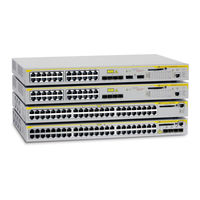Allied Telesis AT-S63 Manuals
Manuals and User Guides for Allied Telesis AT-S63. We have 3 Allied Telesis AT-S63 manuals available for free PDF download: User Manual, Features Manual, Cli User's Manual
Allied Telesis AT-S63 User Manual (668 pages)
Menus User’s Guide For Stand-alone AT-9400 Switches Version 2.2.0 for AT-9400 Layer 2+ Switches Version 3.2.0 for AT-9400 Basic Layer 3 Switches
Brand: Allied Telesis
|
Category: Software
|
Size: 3 MB
Table of Contents
-
Preface
19 -
-
-
Port Type64
-
-
-
-
-
-
-
-
Guidelines176
-
-
-
Guidelines179
-
-
-
-
-
Creating an ACL232
-
Modifying an ACL235
-
Deleting an ACL237
-
Displaying Acls240
-
-
-
Configuring Cos244
-
-
-
-
-
Advertisement
Allied Telesis AT-S63 Features Manual (538 pages)
Management Software For Stand-alone AT-9400 Switches and AT-9400Ts Stacks
Brand: Allied Telesis
|
Category: Software
|
Size: 3 MB
Table of Contents
-
-
Preface19
-
-
-
Introduction61
-
File Systems73
-
-
Overview94
-
-
-
Overview105
-
Guidelines109
-
-
Overview113
-
Guidelines113
-
-
Overview123
-
Event Messages123
-
Syslog Client124
-
-
Overview137
-
Parts of an ACL139
-
Guidelines140
-
Examples141
-
-
Overview157
-
Classifiers159
-
Flow Groups160
-
Traffic Classes161
-
Policies162
-
DSCP Values166
-
Diffserv Domains167
-
Examples169
-
-
Overview179
-
SYN Flood Attack180
-
Smurf Attack181
-
Land Attack182
-
Teardrop Attack184
-
-
Overview211
-
Restrictions213
-
Guidelines215
-
-
Overview221
-
Snmpv3 MIB Views224
-
Snmpv3 Tables228
-
-
Overview237
-
-
Overview249
-
MSTI Guidelines254
-
-
Overview271
-
-
Overview285
-
Guidelines288
-
-
Overview309
-
Egress Ports310
-
VLAN Hierarchy315
-
Guidelines317
-
-
Overview324
-
-
Vlan ID (VID)327
-
-
Interface Names329
-
Static Routes330
-
Default Routes334
-
Routing Table337
-
Local Interface345
-
-
Local Interface346
-
ARP Table346
-
Default Gateway347
-
-
-
Overview363
-
Master Switch364
-
Backup Switches365
-
Port Monitoring367
-
-
Section VIII371
-
-
-
Overview381
-
Port Roles384
-
-
Guest VLAN396
-
General Steps398
-
Guidelines399
-
-
Overview407
-
-
Overview423
-
Guidelines428
-
-
SSL Encryption429
-
Authentication430
-
Public Keys431
-
Certificates432
-
-
-
Overview439
-
Support for SSH440
-
SSH Server441
-
SSH Clients442
-
-
Class of Service468
-
Event Logs474
-
Gvrp475
-
IGMP Snooping476
-
Port Settings484
-
-
RADIUS Client487
-
TACACS+ Client487
-
Telnet Server495
-
Vlans497
-
Web Server498
-
-
File System507
-
Management Mibs509
-
Port Security510
-
Traffic Control511
-
Virtual Lans511
-
-
Class of Service515
-
Gvrp519
-
Miscellaneous523
-
Port Mirroring524
-
Spanning Tree528
-
Vlans530
-
Index533
-
Allied Telesis AT-S63 Cli User's Manual (464 pages)
Command Line Interface AT-9424T/SP AND AT-9424T/GB LAYER 2+ GIGABIT ETHERNET SWITCHES
Brand: Allied Telesis
|
Category: Software
|
Size: 2 MB
Table of Contents
-
Tables
11 -
Preface
13 -
-
Clear Screen24
-
Exit25
-
Help26
-
Menu28
-
Set Prompt30
-
Show User32
-
-
-
Ping41
-
Purge Ip42
-
Reset Switch43
-
Reset System44
-
Set Asyn48
-
Set Ip Route51
-
Set System55
-
Show Asyn57
-
Show Config58
-
Show Switch62
-
Show System63
-
-
Disable Sntp88
-
Enable Sntp89
-
Purge Sntp90
-
Set Date91
-
Set Sntp92
-
Set Time93
-
Show Sntp94
-
Show Time95
-
-
Show Remotelist102
-
-
Set Switch Port112
-
Show Interface120
-
Show Switch Port122
-
-
Add Switch Trunk132
-
Set Switch Trunk137
-
-
-
Copy146
-
Create Config147
-
Delete File148
-
Rename149
-
Set Config150
-
Show File152
-
-
-
-
Disable Log164
-
Enable Log165
-
Purge Log166
-
Save Log167
-
Show Log170
-
Show Log Status175
-
-
-
Set Ip Igmp186
-
Show Ip Igmp189
-
-
Activate Stp196
-
Disable Stp197
-
Enable Stp198
-
Purge Stp199
-
Set Stp200
-
Bridge Priority201
-
Set Stp Port203
-
Show Stp205
-
-
-
Activate Rstp208
-
Disable Rstp209
-
Enable Rstp210
-
Purge Rstp211
-
Set Rstp212
-
Default Values215
-
Set Rstp Port216
-
Show Rstp219
-
-
-
Activate Mstp223
-
Add Mstp224
-
Create Mstp225
-
Delete Mstp226
-
Disable Mstp228
-
Enable Mstp229
-
Purge Mstp230
-
Set Mstp231
-
Set Mstp Cist234
-
Set Mstp Msti236
-
Set Mstp Port239
-
Show Mstp242
-
Advertisement


